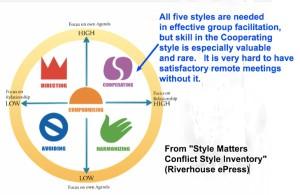What’s your experience of meetings?
“They’re boring. They’re useless. Everyone hates them.  So why can’t we stop meetings?” laments a recent article in the New York Times, “Meet is Murder.”
So why can’t we stop meetings?” laments a recent article in the New York Times, “Meet is Murder.”
Research by Fuze, a telecommunications company, finds organizations spend 15% of their staff time in meetings. For upper level managers, it’s 50%! Yet meeting facilitation methods in most organizations are clumsy and out-of-date.
That needs to change. As online meetings become more common and participants separated by miles increasingly gather electronically, inept facilitation becomes intolerable. The digital age raises the priority of skilled meeting facilitation for organizations.
Why? To get things done in remote meetings, with people connected only through the thin linkages of screens and speakers, facilitators have to provide extraordinarily high levels of guidance and control. Being proactive and assertiveness is paramount. Facilitators must keep participants who are in multiple locations on the same page, prevent awkward silences and verbal collisions, and guide the group through appropriate and efficient problem-solving and decisionmaking approaches.
____________________________________________
On both self-assertive and other-oriented:
Facilitate with high assertiveness, yet simultaneously
support the people involved?
It’s a stretch that will really make you grow.
____________________________________________
And assertiveness is only half the story – high support for the people involved is also required. Lack of physical proximity robs digital interaction of warmth. Facilitators must amp up existing skills and learn new ones to satisfy, at least to some extent, the longing for recognition and connection that makes human beings willing to put in the effort that successful meetings require.
Being simultaneously assertive and supportive is paradoxical. It requires a combination of skills that don’t come naturally to everyone. But fortunately, building such skills for meeting facilitation is low-hanging fruit, offering one of the easiest ways to improve morale and effectiveness of your team or organization. A modest investment of training time in a group of facilitators in your organization can rather quickly upgrade meeting dynamics.
The paradoxical requirements for online facilitation correspond to the conflict style that my Style Matters conflict style inventory refers to as a Cooperating style, and the Thomas Kilmann inventory calls a Collaborating style. Ability to use this style is important, of course, for leaders in all kinds of settings. But if your team works remotely and meets on digital devices like phone or video, it’s foundational to success.
The Cooperating style has two key components: Commitment to tasks or goals and commitment to relationships. In the diagram below, you see how that combination differentiates it from other styles of dealing with issues and making decisions. It is the only style with a high commitment both to goals and to relationships (slideshow with details here).
That’s an unusual blend. You have to be assertive and push for your goals to meet the first requirement. Yet you have to be attentive, flexible, and considerate to meet the second. Self-assertion is a different energy than affirmation of others.
But it can be done, both in conflict and in meeting facilitation. Below is a real-life clip of a facilitator leading a group through a 7 minute standup meeting. I know nothing about this group, but their “Daily Huddle” demonstrates things worth noticing.
Granted, that meeting has a limited purpose. It’s little more than an information-packed hello to the day, neither a model for decisionmaking, nor, let us hope, a foreshot of all meetings of the future. But in a short span of time we see several key aspects of Cooperative style facilitation:
– Designated leader, clearly in charge. Facilitating in the Cooperating style requires the facilitator to actively guide and shape the process of interaction. He opens things crisply and guides the group smartly through several phases, backed at point by references to visual support materials. He’s in control of the process (not content, mind you) the whole time.
– Clear, agreed structure for the meeting. The overall framework is clear and supported by all. Obviously they’ve been doing this for a while and everyone knows what is expected. The facilitator exercises strong, assertive leadership in guiding the group through the familiar framework. No one knows every detail of the agenda of course. Unexpected things happen. But the framework is understood – the facilitator moves things briskly along and the group do their part by keeping things brief.
– Preparation and succinctness.People have prepared, including visual points of reference. They are disciplined in being focused and brief, starting with the facilitator. It ought to be this way in face-to-face meeting, too, but it has to be this way for digital gatherings to be effective. Achieving focus and brevity requires effort and practice. For a while facilitators will need to cue people before meetings to be ready and brief. Gradually these disciplines become part of the organization’s culture.
– Responsiveness to others, modeled by the facilitator and mirrored by all. I’m not talking about mere politeness – any jack can grit his teeth and make nice. Notice that the facilitator actually does little talking. He guides the framework but he mainly sets the stage to help others communicate. Even as he moves the meeting firmly through its phases, he gives space for people to talk and shape the interaction.
Participants actively recognize others, including expressions of appreciation and support. An atmosphere of taking relationships seriously prevails, despite the breathless pace. That doesn’t happen overnight; it emerges as the culture of a group, over time and only where there is consistent modeling of it by leaders and support for it by key people scattered through the organization.
____________________________________________
Lack of physical proximity
robs digital interaction of warmth.
Facilitators must amp up existing skills and learn new ones
to satisfy the longing for recognition and connection
that makes human beings willing to put in the effort
that successful meetings require.
____________________________________________
Vast amounts of time are wasted in meetings. It’s surprisingly easy to change this, but it doesn’t happen by just lamenting long meetings or setting timers. Meetings have to be led by facilitators skilled at the Cooperating style.
Yes, other styles of leadership are needed too. Directing, Harmonizing, Compromising, even Avoiding – all have their place. But Cooperating, with its unusual combination of assertiveness and supportiveness, is the style that requires thought and practice to master.
A good place to start is building skill in Cooperating in one-on-one personal relationships. Use the Style Matters inventory or the Thomas Kilmann Conflict Mode Instrument for that. With that foundation, there are lots of good facilitation guides out there and plenty of facilitation trainers to help learn tools for taking this fundamental awareness into group leadership.
Anyone can drive a group fast through an agenda – just go nazi and forget feelings and relationships. Anyone can help a group lighten up and have fun – just add a few relational components.
But facilitate with high assertiveness in meetings and simultaneously attend to the people involved? That stretch will really make you grow. Share what you’ve learned about how to achieve it!


